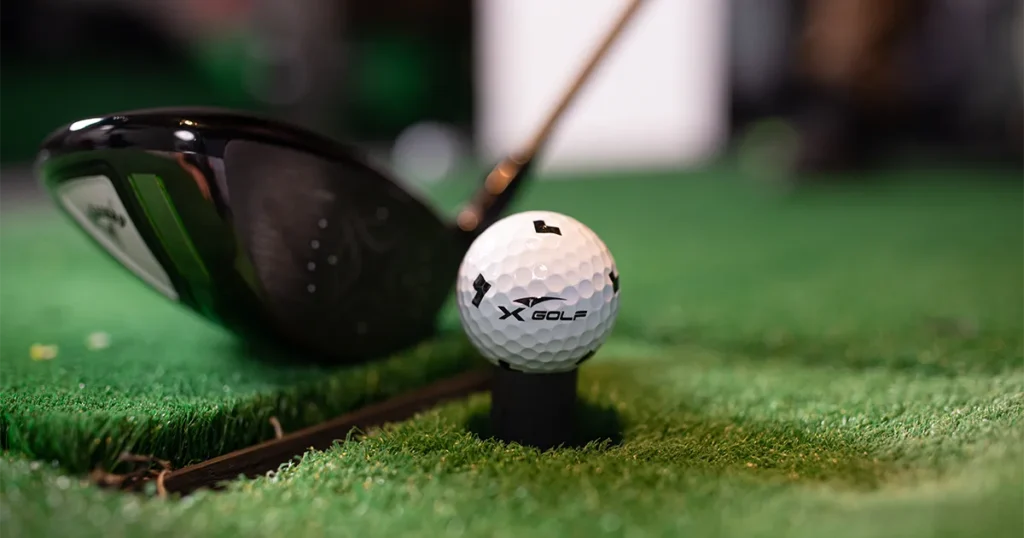
Feeling lost when someone says they “sliced their drive into the rough and took a bogey after missing a gimme putt”? You’re not alone.
Golf speaks its own language. And when you’re new to the game, this unique terminology can feel like an intimidating barrier between you and actually enjoying yourself on the course.
Golf’s vocabulary has evolved over centuries – from “albatrosses” to “zippers” – often leaving newcomers confused and out of place when they just want to have fun.
This guide breaks down essential golf terms in plain English, helping you:
- Understand conversations on the course
- Play more confidently
- Avoid those awkward moments when everyone laughs at golf lingo and you’re left smiling politely
We’ve organized everything into three learning stages that match your journey into the game:
- Day 1 Essentials
- First Month Vocabulary
- Advanced Beginner Terms
Start with what matters right now and build your knowledge as you progress. Each section builds logically on the one before it.
At X-Golf, we believe understanding the language is your first step to enjoying the game. By the time you finish this guide, you’ll be joining golf conversations with confidence and navigating the course with ease.
Let’s build your golf vocabulary!
Day 1 Essentials Golf Terms
Before you step onto a golf course or simulator for the first time, you’ll need to know these fundamental terms. Think of them as your golf survival vocabulary.
The Basics
Par
The number of strokes a good golfer should need to complete a hole. Par-3 means a pro should finish in 3 shots, par-4 in 4 shots, and so on. When someone asks “what’s the par on this hole?” – this is what they mean.
Tee/Teeing Ground
This is your starting point for each hole. It’s where you’ll place your ball on that little wooden or plastic peg (also called a tee) and take your first swing.
Green
The smooth, closely-mown area surrounding the hole where the flagstick stands. This is where you’ll use your putter. The grass here is cut super short so balls can roll smoothly.
Fairway
Think of this as the “highway” to the green – it’s the short grass between the tee and green where you want your ball to land. Stay on the fairway, and your next shot will be much easier.
Rough
Missed the fairway? You’re probably in the rough – the longer grass that borders the fairway. Shots from here are more challenging (and often humbling for beginners).
Golf Equipment
Driver
The biggest club in your bag with the longest shaft. It’s designed for maximum distance off the tee. (It’s also the club most beginners try to hit too hard!)
Irons
Your workhorses – numbered 3-9, these clubs are used for a variety of shots. Higher numbers (7-9) go shorter distances but with more height.
Wedges
Specialized irons for shorter shots. When you need to get the ball up quickly or out of a sand trap, reach for a wedge.
Putter
Your most-used club. The putter is designed for rolling the ball on the green into the hole. Some golfers get very superstitious about their putters!
Golf Ball
Those small, dimpled white balls you’ll be chasing around the course. The dimples actually help it fly farther (there’s science involved).
Tee (equipment)
That small peg you’ll place under your ball for your first shot on each hole. They come in different heights – longer ones for drivers, shorter ones for irons.
Basic Scoring & Rules
Stroke
Any swing with intention to hit the ball counts as a stroke – even if you whiff it completely! (And yes, those embarrassing complete misses still count on your scorecard).
Hole-in-One
The golf equivalent of winning the lottery – when your first shot goes directly into the hole. Buy drinks for everyone if this miraculously happens to you!
Handicap
A number representing your playing ability that lets players of different skill levels compete fairly. Lower numbers mean better golfers. (Don’t worry about this on day one.)
Common Golf Actions & Issues
Swing
The motion used to strike the ball. Everyone’s is different, and you’ll spend years refining yours.
Drive
Your first shot on longer holes, typically hit with your driver for maximum distance.
Putt
When you roll the ball along the green toward the hole with your putter. Looks deceptively simple but can be the most frustrating part of golf.
Slice
When your ball curves dramatically to the right (for right-handed players). The nemesis of most beginners and the reason many golf balls end up in the woods.
Hook
The opposite of a slice – when your ball curves sharply to the left (for right-handers). Slightly less common for beginners but equally frustrating.
Yardage
How far you are from your target. In the US, we measure in yards rather than meters. Knowing your personal yardages with each club is crucial as you improve.
First Month
Common vocabulary you’ll encounter regularly during your first few weeks on the course.
Course Features & Navigation
Bunker/Sand Trap
A hazard filled with sand designed to make you question why you took up this sport. Getting out cleanly requires proper technique and a bit of confidence.
Water Hazard
Lakes, ponds, and streams that seem to attract golf balls like magnets. Hitting into one adds a penalty stroke to your score and costs you a ball.
Out of Bounds
Areas outside the designated playing area, marked by white stakes. If your ball goes here, you’ll need to replay the shot with a one-stroke penalty (which is why it’s smart to pack extra balls).
Dog Leg
A hole that bends left or right, requiring you to think strategically rather than just hitting as far as possible. The course designer is testing your course management, not just your distance.
Cart Path
Paved trails for golf carts. Sometimes you’ll need to keep your cart on these paths to protect the course, especially after rain.
Pin/Flagstick
The marker with a flag that shows you where the actual hole is located on the green. Positions typically change daily at most courses.
Fringe
The area surrounding the green where the grass is cut slightly higher than the putting surface but lower than the rough. A good place to land if you barely miss the green.
Apron/Collar
Another term for the fringe area around the green. When you hear either term, people are talking about that transition zone between rough and putting surface.
Scoring Terms
Birdie
Completing a hole one stroke under par. For beginners, these are rare and celebration-worthy achievements.
Bogey
Completing a hole one stroke over par. For most beginners, this is actually a good score!
Double Bogey
Completing a hole two strokes over par. As a beginner, this is often a realistic target on more difficult holes.
Eagle
Completing a hole two strokes under par. Incredibly rare for beginners—if you get one, take a picture of your scorecard.
Score Card
The card where you track strokes on each hole. Also shows hole distances, pars, and handicap information. Keep it dry and bring a pencil.
Front Nine/Back Nine
The first and second half of an 18-hole course. “Let’s grab lunch after the front nine” means after the first 9 holes.
Shot Types & Techniques
Draw
A controlled shot that curves slightly from right to left for right-handed players. Not a shot most beginners can execute consistently, but something to aspire to.
Fade
A controlled shot that curves slightly from left to right for right-handed players. The difference between a fade and a slice is intention and degree.
Approach
A shot intended to reach the green. Focus on getting these close to the pin to improve your scores quickly.
Lay Up
A strategic shot that intentionally falls short of a hazard or green. Sometimes playing it safe is the smartest move, especially for beginners.
Chip
A short shot typically played near the green, with the ball spending more time rolling than flying. Essential for scoring well.
Pitch
A short, high shot to the green, with the ball spending more time in the air than rolling. Used when you need to get over something between you and the hole.
Divot
The piece of turf displaced when striking the ball with an iron. Good players take divots—they’re a sign you’re hitting down on the ball properly.
Address
The position and stance taken before swinging at the ball. Good fundamentals here set you up for success in the actual swing.
Etiquette & Rules
Fore!
A warning shouted when your ball might hit other players. Learn to yell this loudly and immediately—safety comes first on the course.
Honor
The right to tee off first, usually earned by winning the previous hole. In friendly games, this isn’t strictly followed.
Ready Golf
Playing when ready rather than strictly following the honor system. This keeps play moving and is encouraged in most casual settings.
Gimme
In casual play, a putt close enough to the hole that friends allow you to pick it up and count it as made. Distance varies by how nice your friends are.
Mulligan
A do-over after a poor shot. Not allowed in official play but common in friendly rounds, especially for beginners. “Can I take a mulligan on that drive?”
Casual Water
Temporary water on the course after rain. You’re allowed free relief from these puddles—no need to splash around.
Relief
The procedure for legally moving your ball from a problematic position. There are specific rules about where and how to place your ball.
Penalty Stroke
An additional stroke added to your score for rule violations or hitting into hazards. These add up quickly, so learn to avoid situations that cause them.
Equipment Terms
Woods
Clubs with larger heads used for longer shots. Despite the name, they’re now made of metal. Your driver is technically a 1-wood.
Hybrids
The “rescue clubs” that combine features of woods and irons. These are more forgiving than long irons and great for beginners.
Grip
Both the rubber covering on your club handle and how you hold the club. A good grip is the foundation of a good swing.
Head Cover
Protective covering for woods, hybrids, and putters. These prevent damage when clubs bang together in your bag during a round.
Tee Box
The specific area within the teeing ground where you place your tee. Different colored markers indicate different playing distances.
Advanced Beginner Terms
Once you’ve played regularly for a few months, you’ll start hearing these more advanced terms. Understanding them separates casual players from those who are getting serious about the game.
Advanced Shot Descriptions
Flop Shot
An extremely high, soft shot that stops quickly on the green. Think Phil Mickelson’s signature shot that seems to defy gravity. Challenging for beginners but occasionally necessary around the greens.
Punch Shot
A low trajectory shot used in windy conditions or to play under tree branches. You’ll typically play the ball back in your stance and limit your follow-through.
Bladed
Hitting the ball with the leading edge of the club rather than the face, sending it rocketing across the green. Usually followed by muttering under your breath.
Chunked/Fat
Hitting behind the ball, taking too much turf before contact. Those large divots that fly further than your ball? That’s a chunked shot.
Shank
The most feared shot in golf – when the ball connects with the hosel (where the clubhead meets the shaft), sending it sharply right at a 90-degree angle. Mention this word too often and you might get kicked off the course.
Topped
Hitting the ball above its equator, causing it to roll along the ground instead of flying. A common issue for beginners trying to “lift” the ball instead of letting the club do the work.
Lag Putt
A long putt with the primary goal of getting close to the hole rather than in it. Good lag putting is the secret to avoiding three-putts.
Up and Down
Getting the ball into the hole in two strokes (typically a chip and a putt) from off the green. A sign your short game is improving.
Skulled
Similar to a bladed shot, hitting the ball too high on the clubface. The ball typically flies hot and low with little control.
Course Management Terms
Pin Position
The specific location of the hole on the green. Courses change these positions regularly to spread out wear and tear and create different challenges.
Stimp/Stimp Reading
A measurement of green speed. Higher numbers mean faster greens. When someone complains “these greens are running at an 11 today,” they’re referring to the Stimp reading.
Break
The amount a putt will curve due to the contour of the green. Reading break correctly separates good putters from great ones.
Grain
The direction in which the grass on the green is growing, affecting putts. More noticeable on Bermuda grass greens in southern regions.
Tiered Green
A green with distinct levels or sections. If your ball is on the wrong tier from the hole, two-putting becomes a significant achievement.
Approach Angle
The direction from which you approach the green, affecting strategy. Some pin positions are more accessible from certain angles.
Elevation Change
Uphill or downhill aspects of a hole that affect club selection and strategy. Uphill shots play longer, downhill shots play shorter.
Risk/Reward
A situation offering a potentially better outcome but with higher penalty for failure. That shortcut over the water might save you a stroke—or cost you two.
Lie
The position of the ball on the course. A good lie sits up nicely on the grass; a bad lie is nestled down or on uneven ground.
Equipment Details
Loft
The angle of the clubface that affects trajectory and distance. More loft = higher flight but shorter distance.
Lie Angle
The angle between the shaft and the ground when the club is at address. Proper fitting ensures this matches your swing.
Cavity Back
An iron design with weight distributed around the perimeter, more forgiving for beginners. Most new golfers should start with these.
Blade
A traditional iron design with a thin clubhead, preferred by better players for workability and feel. They look beautiful but punish mishits severely.
Graphite vs. Steel
Shaft materials affecting weight, flex, and feel. Graphite is lighter and often better for slower swing speeds; steel offers more control for faster swingers.
Club Length
The measurement from grip end to clubhead, affecting swing dynamics. Custom length can improve consistency based on your height and arm length.
Bounce
The angle between the leading edge and the lowest point of the sole on wedges. More bounce helps in soft sand; less bounce works better on tight lies.
Alignment Aid
Markings on a putter or ball to help with directional alignment. These visual cues can dramatically improve putting accuracy.
Stableford
A scoring system that awards points based on performance relative to par. Popular in social tournaments because you can pick up after a disaster hole.
Match Play
Competition format where players compete hole by hole rather than total strokes. Win more individual holes than your opponent and you win the match.
Stroke Play
Competition format based on total number of strokes taken. This is what you see most often on TV and in official tournaments.
Provisional Ball
A second ball played when the original might be lost or out of bounds. Saves time rather than walking back to replay the shot if your ball isn’t found.
Winter Rules/Preferred Lies
Local rule allowing improved lies under certain conditions, typically in winter when the course isn’t at its best. “Roll it in the fairway” is a common casual version.
Scramble
A team format where each player hits a tee shot, the best shot is selected, and all play from there. Great for corporate outings and beginners.
Best Ball
A team format where each player plays their own ball, and the best score on each hole counts. Tests your ability to contribute when your teammates struggle.
Drop
Procedure for putting a ball back into play after a penalty. There are specific rules about how high to drop from and where.
Pace of Play
The expected time to complete a round. Being “on pace” means you’re keeping up with the group ahead of you.
Golf Psychology & Sayings
Yips
A nervous condition affecting putting or chipping, causing unexpected jerky motions. The golfing equivalent of stage fright that can affect even pros.
Mental Game
The psychological aspects of golf performance. As you improve, you’ll realize golf is as much mental as physical.
Pre-shot Routine
The consistent sequence of actions before each shot. Developing one helps create consistency and confidence in your game.
Target Golf
An approach focusing on specific landing zones rather than just distance. Good players think about where they want the ball to land, not just how far they want to hit it.
Course Management
Strategic decision-making to maximize scoring potential. Knowing when to be aggressive and when to play it safe distinguishes experienced players from beginners.
Don’t Just Learn the Terms—Put Them Into Play at X-Golf
Now that you’ve built your golf vocabulary from Day 1 Essentials to Advanced Beginner terms, imagine yourself confidently using these words the next time you step onto the simulator.
Remember: Every golfer started exactly where you are now. The pros on TV once didn’t know a birdie from a bogey. The terminology might seem overwhelming at first, but it will become second nature faster than you expect.
Ready to test your new golf vocabulary in real life? The best way to cement this knowledge is through practice.
Book a Tee Time at X-Golf today and start using these terms in context. Our simulators provide the perfect low-pressure environment to practice both your swing and your golf lingo before hitting the actual course.


